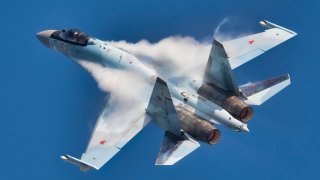Russia's Su-35 Flanker Fighter Keeps 'Falling Out of the Sky' in Ukraine
The Russian Su-35 Flanker is a highly capable air superiority fighter, designed to clear enemy aircraft from the skies. Equipped with powerful engines and advanced munitions, the Su-35 can achieve speeds of Mach 1.9 and carry up to 18,000 lbs of weaponry.
Summary and Key Points You Need to Know: The Russian Su-35 Flanker is a highly capable air superiority fighter, designed to clear enemy aircraft from the skies. Equipped with powerful engines and advanced munitions, the Su-35 can achieve speeds of Mach 1.9 and carry up to 18,000 lbs of weaponry.
-However, in the conflict in Ukraine, the Su-35's effectiveness has been limited by Ukraine’s potent air defenses, including U.S.-supplied Patriot systems.
-Russia has lost at least half a dozen Su-35s in the conflict, including one shot down by friendly fire. Despite its capabilities, the Su-35 requires electronic warfare support to operate effectively in contested airspace.
The Russian military has a legacy of highly capable fighter jets. Although the Russian defense and aerospace industries have fallen behind their American and Chinese competitors in recent years, the Russian Aerospace Forces continue to fly some impressive aircraft. The Su-35 Flanker is one of them.
Russia’s Flanker
The Su-35 is a single-seat, all-weather supersonic fighter jet designed and built for the Russian Aerospace Forces.
The Flanker is an air superiority fighter jet. The fighter is designed to operate alongside other aircraft, such as the Su-34 Fullback fighter-bomber, and clear enemy planes from the skies.
The Su-35 Flanker can hit a maximum speed of around Mach 1.9 (or around 1,485 miles per hour) and has an operational range of about 1,000 miles, which can be increased to nearly 3,000 miles with the addition of external tanks and optimum flying. Moreover, it can operate up to 60,000 feet and sustain gravity forces of up to 9 Gs. The aircraft can achieve the above performance due to its twin Saturn/UFA AL-41F-1S engines, each of which can produce almost 32,000 lbs of force.

This Russian fighter jet can carry almost 18,000 lbs of munitions on 12 hardpoints (10 in the fuselage and wings, two on wingtip rails). That amount of munitions can sustain air combat for long periods of time.
The Su-35 Flanker can carry a wide range of air-to-air and air-to-ground weapons including R-77 active radar-homing beyond-visual-range air-to-air missiles; R-73 heat-seeking air-to-air missiles; R-27 radar-homing air-to-air missiles; Kh-59 air-to-ground missiles; Kh-31 air-to-ground munitions; KAB-500 and KAB-1500 guide bombs; unguided rockets; and conventional bombs. In addition, the Russian fighter jet sports a GSh-301 30 mm cannon with 150 rounds for air combat and strafing runs.
In production since 2007, Sukhoi has produced around 150 Su-35 Flankers for the Russian Aerospace Forces and the Chinese air force.
The Fighting in Ukraine and Su-35
The Su-35 Flanker has been actively engaged in the fighting in Ukraine. However, the potent air defense capabilities of the Ukrainian military have largely negated the utility of the Su-35. As an air superiority fighter, the Su-35 Flanker needs electronic warfare cover to operate over a semi- or non-permissive battlefield.
The Su-35 was involved in one of the most humiliating episodes of Russia’s war in Ukraine. Last September, Russian air defenses mistakenly shot down a Russian Su-35S Flanker that was returning from a mission near the frontlines in Tokmak, southern Ukraine.
Overall, the Russian Aerospace Forces have lost at least half a dozen Su-35 fighter jets in the fighting. When Ukraine put into action its U.S.-made MIM-104 Patriot air defense systems, Russian aircraft losses started piling up. Since then, the Russian military has been much more careful with how it uses its Su-35s.
About the Author:
Stavros Atlamazoglou is a seasoned defense journalist specializing in special operations and a Hellenic Army veteran (national service with the 575th Marine Battalion and Army HQ). He holds a BA from the Johns Hopkins University and an MA from the Johns Hopkins’ School of Advanced International Studies (SAIS). His work has been featured in Business Insider, Sandboxx, and SOFREP.
Image Credit: Creative Commons and/or Shutterstock.


